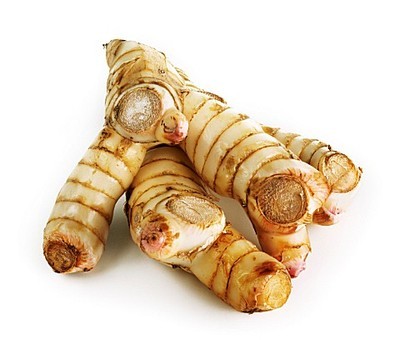
Common Name: Kulinjan
English Name: Greater Galangal, Java Galangal
Botanical Name: Alpinia galangal Wild.
Family: Zingiberaceae
Description: The herb grows to a height of about 5 feet, the leaves being long, rather narrow blades, and the flowers, of curious formation, growing in a simple, terminal spike, the petals white, with deep-red veining distinguishing the lippetal.
The branched pieces of rhizome are from 1 1/2 to 3 inches in length, and seldom more than 3/4 inch thick. They are cut while fresh, and the pieces are usually cylindrical, marked at short intervals by narrow, whitish, somewhat raised rings, which are the scars left by former leaves. They are dark reddish-brown externally, and the section shows a dark centre surrounded by a wider, paler layer which becomes darker in drying. Their odour is aromatic, and their taste pungent and spicy. They are tough and difficult to break, the fracture being granular, with small, ligneous fibres interspersed throughout one side. Although galanga leaves are aromatic, they are not often used for flavouring purposes. The same holds for the seeds, which could be used in place of cardamom.
Chemical Constituents: It was reported to contain, among other components, essential oils, tannins, phenol, glycosides, monoterpenes and carbohydrates. New compounds such as Galangol, Kaempferide, Pholobaphene, gallic acid glycoside, galangoisoflavonoid,β-sitosterol, galangin, alpinin, zerumbone and kampferide have been isolated from various parts of A. galangal.
Properties: This herb improves digestion process, and reduce constipation and vomiting. Galangal has been known to improve blood circulation, especially in the hands and feet, thereby improving oxygen supply and nutrient supply to these parts. The galangal herb is used extensively throughout the East as a snuff for nasal infections. The roots of A. galanga are used for eczema, bronchitis, coryza, morbili, pityriasis versicolor, otitis interna, gastritis, ulcers, cholera, and the seed of A galanga is used for emaciation. It is used for nervous debility and nervous diseases and it stimulates and strengthens the nerves.It helps to clean the mouth, stimulates the digestive power, appetite and acts as a purgative. It also prevents anorexia and abdominal pain Alpinia increases the blood supply to the gastrointestinal system and as a result it reduces the cardiac contractions, cardiac output and blood supply to the vital organs. It dilates the bronchioles and reduces asthma. It strengthens the laryngeal folds. It can also be used for speech defects such as dysarthria, stammering and aphasia. It slightly reduces the ability of urine production and used for polyuria and other urine disorder formulations.
Used in the following MATXIN products: